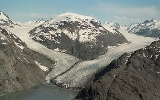
Muir Glacier
Encyclopedia
Muir Glacier is a glacier
in Glacier Bay National Park and Preserve
in the U.S. state
of Alaska
. It is currently about 0.7 km (0.434960915654865 mi) wide at the terminus. As recently as the mid-1980s the glacier was a tidewater glacier and calved
iceberg
s from a wall of ice 60 m (200 feet) tall.
Muir Glacier has undergone very rapid, well-documented retreat since its Little Ice Age
maximum position at the mouth of Glacier Bay around 1780. Between 1941 and 2004 the glacier retreated more than twelve kilometers (seven miles) and thinned by over 800 meters (2625 feet). Ocean water has filled the valley replacing the ice.
The glacier is named after John Muir
, the naturalist, who travelled around the area and wrote about it, generating interest in the local envirnoment and in its preservation. His first two visits were in 1878 (at age 41) and 1880. During the visits, he sent an account of his visits in installments to the San Francisco Bulletin. Later, he collected and edited these installments in a book, Travels in Alaska, published in 1915, the year after he died.
Glacier
A glacier is a large persistent body of ice that forms where the accumulation of snow exceeds its ablation over many years, often centuries. At least 0.1 km² in area and 50 m thick, but often much larger, a glacier slowly deforms and flows due to stresses induced by its weight...
in Glacier Bay National Park and Preserve
Glacier Bay National Park and Preserve
Glacier Bay National Park is a national park in Alaska. The area around Glacier Bay in southeastern Alaska was first proclaimed a U.S. National Monument on February 25, 1925. It was changed to Glacier Bay National Park and Preserve on Dec. 2, 1980 by the Alaska National Interest Lands Conservation...
in the U.S. state
U.S. state
A U.S. state is any one of the 50 federated states of the United States of America that share sovereignty with the federal government. Because of this shared sovereignty, an American is a citizen both of the federal entity and of his or her state of domicile. Four states use the official title of...
of Alaska
Alaska
Alaska is the largest state in the United States by area. It is situated in the northwest extremity of the North American continent, with Canada to the east, the Arctic Ocean to the north, and the Pacific Ocean to the west and south, with Russia further west across the Bering Strait...
. It is currently about 0.7 km (0.434960915654865 mi) wide at the terminus. As recently as the mid-1980s the glacier was a tidewater glacier and calved
Ice calving
Ice calving, also known as glacier calving or iceberg calving, is a form of ice ablation or ice disruption. It is the sudden release and breaking away of a mass of ice from a glacier, iceberg, ice front, ice shelf, or crevasse...
iceberg
Iceberg
An iceberg is a large piece of ice from freshwater that has broken off from a snow-formed glacier or ice shelf and is floating in open water. It may subsequently become frozen into pack ice...
s from a wall of ice 60 m (200 feet) tall.
Muir Glacier has undergone very rapid, well-documented retreat since its Little Ice Age
Little Ice Age
The Little Ice Age was a period of cooling that occurred after the Medieval Warm Period . While not a true ice age, the term was introduced into the scientific literature by François E. Matthes in 1939...
maximum position at the mouth of Glacier Bay around 1780. Between 1941 and 2004 the glacier retreated more than twelve kilometers (seven miles) and thinned by over 800 meters (2625 feet). Ocean water has filled the valley replacing the ice.
The glacier is named after John Muir
John Muir
John Muir was a Scottish-born American naturalist, author, and early advocate of preservation of wilderness in the United States. His letters, essays, and books telling of his adventures in nature, especially in the Sierra Nevada mountains of California, have been read by millions...
, the naturalist, who travelled around the area and wrote about it, generating interest in the local envirnoment and in its preservation. His first two visits were in 1878 (at age 41) and 1880. During the visits, he sent an account of his visits in installments to the San Francisco Bulletin. Later, he collected and edited these installments in a book, Travels in Alaska, published in 1915, the year after he died.

